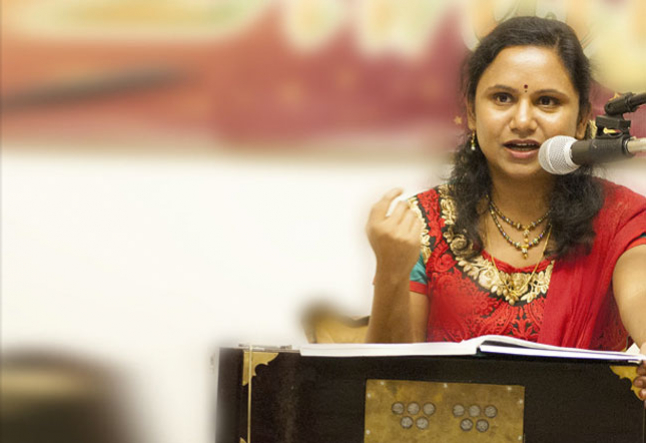finding the true meaning of kirtan

yoga music kirtan spirituality
I remember the bluish-grey sky, the sun peeking out from behind the clouds, cars zooming past ours on the multi-lane freeway and a sense of child-like wonderment when I first landed at LAX, from India, in December 2002. I was newly married to a man living and working in the US, whose tall skyscrapers, American-English, dollar bills, vast freeways and thousands of cars were all new experiences for me.
During the first couple of months, I missed my home country badly. But I soon got busy settling down and learning a new way of life. I had to relearn lots of mundane tasks: driving on the right side of the road, American words like ‘cab’ for ‘taxi’, ‘eggplant’ for ‘brinjal’. I began to look for Indian connections and thanks to the Internet, I was quickly able to find several sites that provided lists and resources for Indian music schools, yoga classes, restaurants, grocery shops and temples.
I would often reminisce about my childhood days; when a little me would hold my mom’s hand and walk across the street to a small gathering on Thursdays for Kirtans. This was my first introduction to Kirtan singing. The organizer would distribute small pieces of paper to the singers. It had a particular deity’s name, followed by a number, scribbled on them. My mom would look at it and plan what to sing, the number would indicate when it was her turn.
Slowly, I started singing along with her and then started leading some myself. People would often praise my voice and I made every effort to sing better next time. Kirtans ignited my interest in learning Indian Classical music. Looking back, I had no idea that music and Kirtan would become my life-long journey.
After moving to LA, I missed Indian classical music the most. Back in India, I was part of a large group of devoted musicians, working together to grow and serve our community by creating awareness about classical music; a tradition that was fading away and getting replaced rapidly by the pop culture of the West. This was the type of work I loved doing, and finding myself in a land where this was no longer relevant made me homesick.
Thankfully, there were several yoga centres scattered all over LA where I met wonderful people; some of whom had been to India and to whom I felt an instant connection. One such visit introduced me to the call and response style of Kirtan singing. I was thrilled and excited to listen to non-native Hindi/Sanskrit speakers singing songs about Krishna and Shiva.
Initially, I had very mixed feelings. On one side, I felt proud that the culture and spirituality of India was being practiced with so much respect and devotion. On the other hand, I could not resist feeling amused by Westerners butchering my language and the names of Gods and Goddesses. I remember how awkward and uncomfortable I felt when people broke into an ecstatic dance in one such Kirtan.
I sat in a corner of a dark yoga room, on a folded yoga blanket, trying to figure out my feelings. Was I offended witnessing a sacred practice turning into a hippie dancing? Or was I happy that all these people felt so much love and freedom that they no longer had to follow strict rules of spirituality and could break free and dance? I had grown up learning that spirituality needs to be revered and one needs to sit straight, spine up, eyes closed, both hands on knees in gyan mudra (touching index finger to thumb).
But I loved the simplicity of Kirtan music using only a guitar, some basic hand-drumming and a voice, so I continued attending Kirtan events. Melodies and rhythms that were easy to follow were great for singing ‘call and response’ style. Musicianship was not the focus, but rather chants and mantras. The more I attended these Kirtans with an open mind, the more I received.
It was a great learning experience for me; I realized that the first step of Kirtan singing is to get rid of judgments and let go of ego. When you attend a Kirtan, try to focus on Bhakti instead of how something is pronounced. It doesn’t matter if someone says “Sheeva” instead of “Shiva”. However, if your focus is fixed on Sheeva you won’t be able to receive benefits from Kirtan.
It is the intent and Bhakti that matters. You don’t have to follow set rules on how to sit or whether your eyes are closed or not; sit in a position that is comfortable for you. If you need to use a chair, do so. You do not need to sit in the lotus position if it makes your body uncomfortable, because your focus will shift to the pain and discomfort you experience instead of focusing on Kirtan. Similarly, do not worry about your singing abilities. Kirtan is not about singing at all. Singing is just a tool; it acts as a vehicle to transport us into a deeper state of consciousness.
It is a journey in which we travel together, each individual with their own destinations, experiences and expectations. One common goal is to liberate our minds from day-to-day stresses and constant mind chattering, and connect with our divine selves.
It took me 9000 miles of travel, all the way from India to Los Angeles, to realize what Kirtan singing is all about. I am happy that I was able to look beyond my ego as a singer and learn the true meaning and importance of Kirtans.
Read next >> kirtan kriya